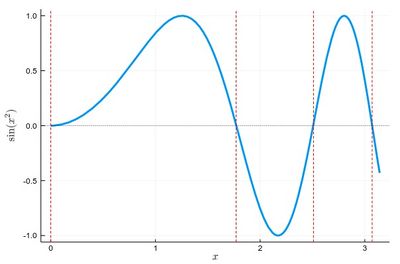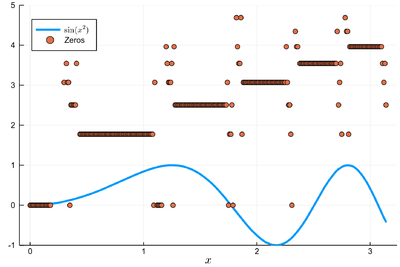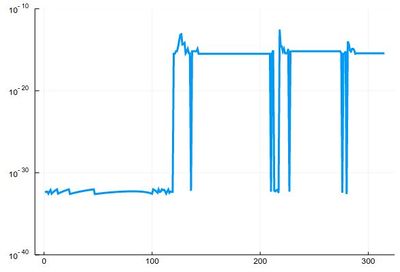m (Created page with "= Crash Course in Scientific Computing = == XV. Root Finding == another typical numerical method: a root-finding algorithm. We used a so-called [https://en.wikipedia.org/wiki...") |
m (→XV. Root Finding) |
||
| Line 1: | Line 1: | ||
= Crash Course in Scientific Computing = | = Crash Course in Scientific Computing = | ||
| − | == | + | == XIII. Root Finding == |
another typical numerical method: a root-finding algorithm. We used a so-called [https://en.wikipedia.org/wiki/Bisection_method bisection method] previously when generating our own random numbers, which is easy to implement but not very efficient. A simple but good improvement is the [https://en.wikipedia.org/wiki/Newton%27s_method Newton–Raphson method] ([[Newton]] used it for the particular case of polynomials; Raphson extended it to arbitrary functions). The idea is to start with a blind guess $x_0$ around the solution and replace the real function $f(x)$ by a linear approximation with the same slope at $x_0$, i.e., $h(x)=f'(x_0)x+\beta$ with $\beta$ such that $h(x_0)=f(x_0)$ which yields | another typical numerical method: a root-finding algorithm. We used a so-called [https://en.wikipedia.org/wiki/Bisection_method bisection method] previously when generating our own random numbers, which is easy to implement but not very efficient. A simple but good improvement is the [https://en.wikipedia.org/wiki/Newton%27s_method Newton–Raphson method] ([[Newton]] used it for the particular case of polynomials; Raphson extended it to arbitrary functions). The idea is to start with a blind guess $x_0$ around the solution and replace the real function $f(x)$ by a linear approximation with the same slope at $x_0$, i.e., $h(x)=f'(x_0)x+\beta$ with $\beta$ such that $h(x_0)=f(x_0)$ which yields | ||
Revision as of 08:39, 22 March 2021
Crash Course in Scientific Computing
XIII. Root Finding
another typical numerical method: a root-finding algorithm. We used a so-called bisection method previously when generating our own random numbers, which is easy to implement but not very efficient. A simple but good improvement is the Newton–Raphson method (Newton used it for the particular case of polynomials; Raphson extended it to arbitrary functions). The idea is to start with a blind guess $x_0$ around the solution and replace the real function $f(x)$ by a linear approximation with the same slope at $x_0$, i.e., $h(x)=f'(x_0)x+\beta$ with $\beta$ such that $h(x_0)=f(x_0)$ which yields
$$h(x)=f'(x_0)[x-x_0]+f(x_0)$$
Now a better guess for the zero is found by solving $h(x)=0$ which has solution $x=x_0-(f(x_0)/f'(x_0))$. Of course the procedure can be iterated so the algorithm gives us the always better approximations:
$$x_{n+1}=x_n-{f(x_n)\over f'(x_n)}\,.$$
Let us find the zeros of $f(x)=\sin(x^2)$ between 0 and $\pi$. It's good to know beforehand the sort of results we expect (we added vertical lines by eye):
psin2=plot(x->sin(x^2), 0, π, ylabel=L"\sin(x^2)",xlabel=L"x",lw=3, legend=false) vline!([0, 1.77, 2.51, 3.07], line = (:red, :dash, 1)) hline!([0], line = (:black, :dot, .75))

The formula gives us:
$$x_{n+1}=x_n-{\sin x_n^2\over 2x_n\cos x_n^2}$$
We can write a function that takes $f/f'$ as an input (that we have to compute ourselves) that computes such iterations until the procedure differs by less than some $\epsilon$:
function NewtonRaphson(f, x0) ϵ=10^-16 x1=x0+10ϵ while abs(x1-x0)>ϵ x0=x1 x1=x0-f(x0) end x1 end
This provides the values found in the $[0,\pi]$ interval:
lsols=[NewtonRaphson(x->sin(x^2)/(2*x*cos(x^2)), x) for x in 0:.01:π]
We can plot the solutions together with where was the starting point:
psin2=plot(x->sin(x^2), 0, π, label=L"\sin(x^2)",xlabel=L"x", legend=:bottomleft)

We found many, in particular some outside the $[0,\pi]$ range (this was the case when the tangent was sending us far away). We can check these are indeed all solutions:
plot(abs.(sin.(lsols.^2)), yscale=:log10, ylims=(10^-40,10^-10), legend=false)

To actually extract the values, we could use unique(), but this would return a lot of different values for the 0 zero, so we'd round this:
lsolss=sort(unique(round.(lsols,digits=10)))
These are the said solution in the sought range:
lsolss[findall(x-> 0<=x<=π, lsolss)]
5-element Array{Float64,1}:
-0.0
0.0
1.7724538509
2.5066282746
3.0699801238
-0.0 and 0.0 are seen as different in julia, surely something that'll be fixed eventually. We have four solutions, as is clear from the initial graph.
There is a Roots package that has a function fzero() that achieves something similar:
fzero(x->sin(x^2), 2)
1.772453850905516